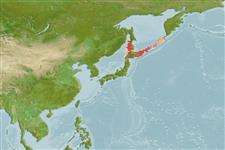Environment: milieu / climate zone / depth range / distribution range
Ecology
Marine; freshwater; brackish; benthopelagic; anadromous (Ref. 51243); depth range 0 - 100 m (Ref. 50610). Temperate; 50°N - 42°N
Northwest Pacific: Sea of Japan, from southern Kuril Islands and Primorskii Krai, Russia to Hokkaido.
Size / Weight / Age
Maturity: Lm ? range ? - ? cm
Max length : 200 cm TL male/unsexed; (Ref. 559); common length : 50.0 cm TL male/unsexed; (Ref. 559); max. published weight: 24.0 kg (Ref. 56527); max. reported age: 16 years
Usually inhabits lower and middle reaches of rivers and lakes. A sea-run form is found in the eastern coast of Hokkaido. Young feed mainly on aquatic insects while fishes more than 30 cm are completely piscivorous. Spawns in spring in river branches, where the female lays 2,000-10,000 eggs on sandy or gravelly bottom.
Life cycle and mating behavior
Maturity | Reproduction | Spawning | Eggs | Fecundity | Larvae
Robins, C.R., R.M. Bailey, C.E. Bond, J.R. Brooker, E.A. Lachner, R.N. Lea and W.B. Scott, 1991. World fishes important to North Americans. Exclusive of species from the continental waters of the United States and Canada. Am. Fish. Soc. Spec. Publ. (21):243 p. (Ref. 4537)
IUCN Red List Status (Ref. 130435)
Threat to humans
Harmless
Human uses
Fisheries: minor commercial; aquaculture: experimental
More information
ReferencesAquacultureAquaculture profileStrainsGeneticsElectrophoresesHeritabilityDiseasesProcessingNutrientsMass conversion
Tools
Special reports
Download XML
Internet sources
Estimates based on models
Preferred temperature (Ref.
123201): 1.6 - 9, mean 6.1 °C (based on 30 cells).
Phylogenetic diversity index (Ref.
82804): PD
50 = 1.0000 [Uniqueness, from 0.5 = low to 2.0 = high].
Bayesian length-weight: a=0.00741 (0.00437 - 0.01257), b=2.97 (2.82 - 3.12), in cm total length, based on LWR estimates for this species & (Sub)family-body (Ref.
93245).
Trophic level (Ref.
69278): 4.5 ±0.5 se; based on diet studies.
Generation time: 22.0 ( na - na) years. Estimated as median ln(3)/K based on 1
growth studies.
Resilience (Ref.
120179): Very Low, minimum population doubling time more than 14 years (Preliminary K or Fecundity.).
Fishing Vulnerability (Ref.
59153): Very high vulnerability (79 of 100).
